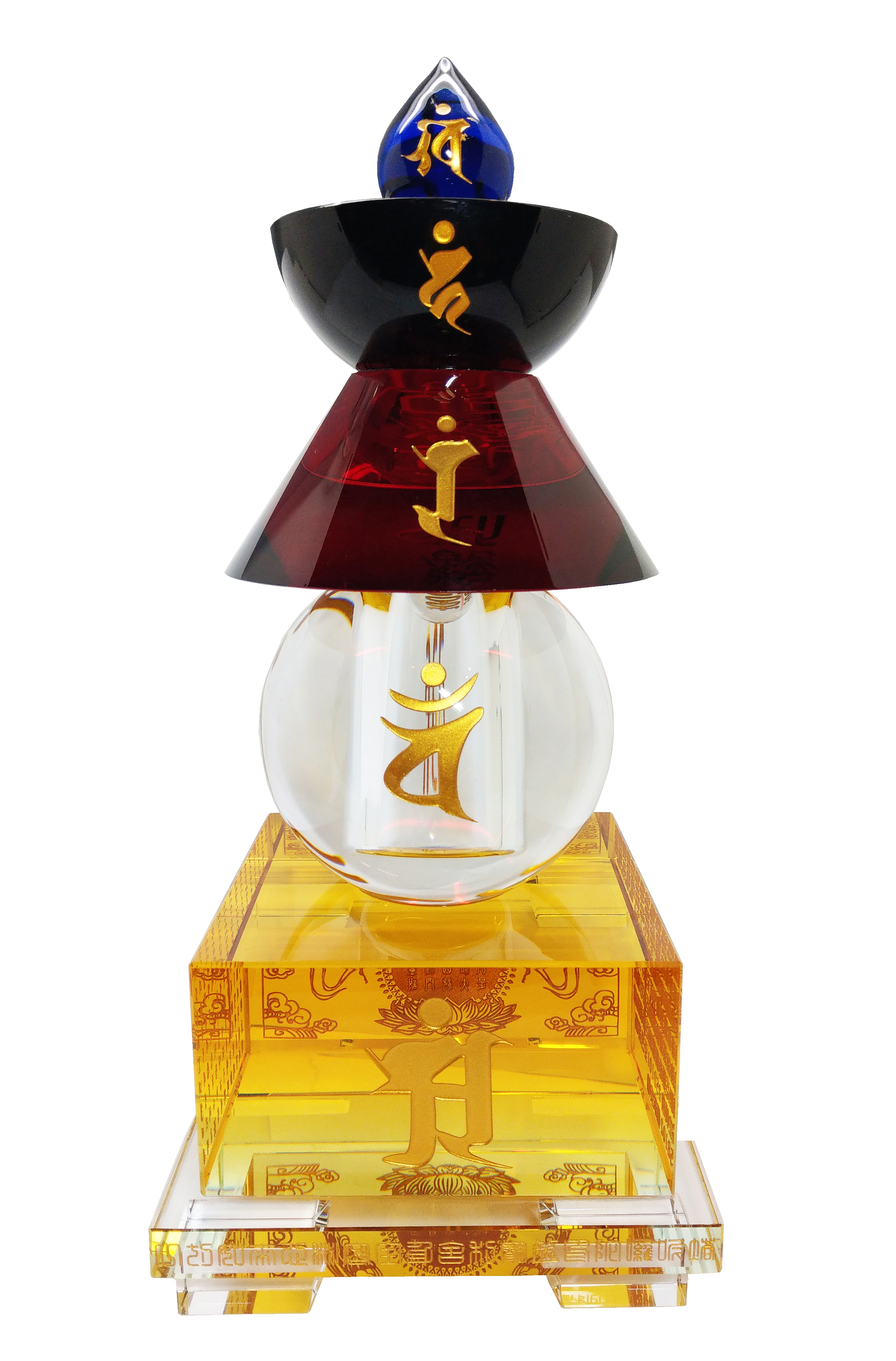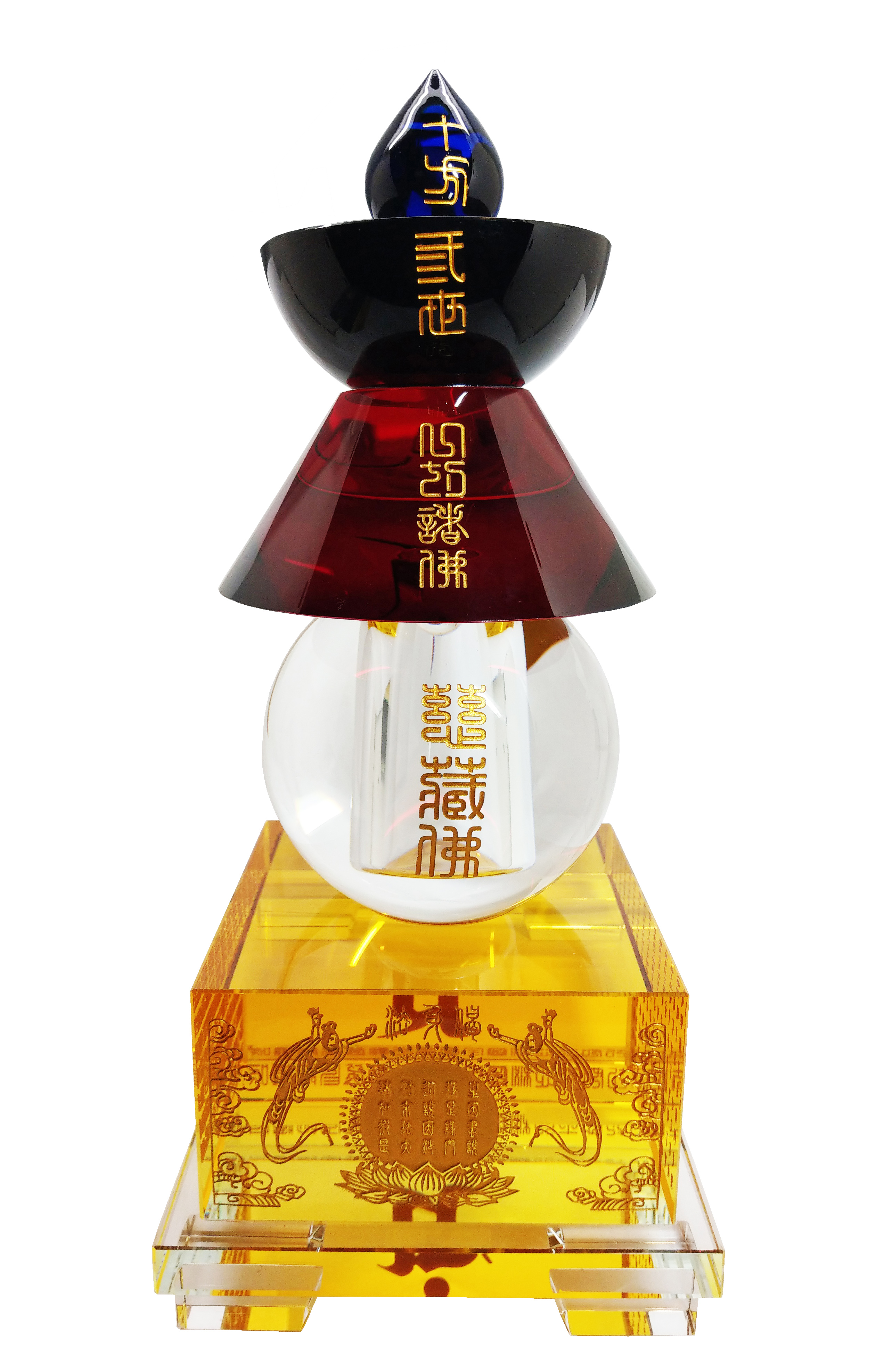|
|
|
Wholesalers: |

|
/ |
|
|
|
|
|
|
|
|
| "All acts of living become bad by ten things, and by avoiding the ten things they become good. There are three evils of the body, four evils of the tongue, and three evils of the mind." Shakyamuni Buddha (563-483 B.C.) |
|
|
|
|
|
|
|
|
|
|
|
|
|
|
|
|
|
|
|
| Great Casket Seal Stupa 35cmH |
|
|
|
| Great Casket Seal Stupa |
|
Sku#:3457
|
|
|
Wholesale price |
US |
XXX.XX |
|
《In order to view the wholesale price .
Please Apply to be a wholesalers》
|
|
|
|
|
 |
|
Please contact us to verify availability. 1-626-354-6228
Email: zambalallc@gmail.com
America area customers can view on this website first.
https://FlyingMystics.org/ |
|
|
|
|
|
|
Materials: Crystal, Painted, Cast, Carved
Dimensions: Base 15 x 15 cm wide x 35 cm high
Description:
The Ratnakara Seal Dharani Crystal Colored Five-Whirl Pagoda (abbreviated as the Ratnakara Seal Five-Whirl Pagoda) is a unique type of Buddhist stupa or offering stupa. It is often crafted from crystal, and its colors symbolize the five elements (earth, water, fire, wind, and space). It originates from the Sutra of the Ratnakara Seal Dharani of the Secret Whole Body Relics of the Heart of All Tathagatas (abbreviated as the Ratnakara Seal Dharani Sutra), and the stupa often contains mantras from that sutra. In Buddhism, this type of stupa is considered a sacred object containing the whole body relics of all Buddhas, endowed with powerful protection and blessings. The crystal material symbolizes purity and transparency, and the colors correspond to the colors of the five elements: yellow (earth), blue or white (water), red (fire), black or green (wind), and white or transparent (space). This type of pagoda is commonly found in Esoteric Buddhism and Chinese Buddhism, particularly in Taiwan, Japan, and mainland China, where it is used for personal worship, temple enshrinement, and burial memorials.
Origin
The origins of the Ratnakara-seal Dharani Sutra can be traced back to the Tang Dynasty (around the 8th century), when it was translated from Sanskrit into Chinese by the renowned translator Amoghavajra. This sutra belongs to the Dharani Tantric tradition, emphasizing the magical power of mantras (Dharani) to bring immeasurable merit to sentient beings. The text itself originated from Indian Buddhism and, after its introduction to China, became a key esoteric text of Chinese Buddhism. The "treasure box" in the Ratnakara-seal Dharani refers to a treasure chest that holds the Buddha's relics and merits, while the "seal" symbolizes its indestructibility, like a seal, providing eternal protection.
The five-wheeled pagoda has its origins in Esoteric Buddhism, originating from the five-wheeled concept of India and Tibet, and later introduced to Japan and China. The Gorin Pagoda first appeared in Japan during the Heian period (9th century). Influenced by Esoteric Buddhism, its five-story design symbolizes the five elements of the universe (earth, water, fire, wind, and space) and is often used in conjunction with the Vajra Seal Dharani. In China and Taiwan, these pagodas are often made of crystal or acrylic, with colorful designs reinforcing the symbolism of the five wheels. The use of crystal, likely derived from modern technology, emphasizes its transparency and purity, symbolizing the purity of the Dharma. According to Buddhist tradition, the construction of a pagoda and the placement of a Dharani transform it into a pagoda made of seven treasures, thus receiving the protection of the heavens.
The story of the sutra unfolds in narrative form, rich in miraculous and didactic elements:
Thus have I heard, once Shakyamuni Buddha was in the Precious Light Pond in the Pure Garden of Magadha (ancient India), surrounded by an immense multitude of great bodhisattvas, great voices, and the Eight Classes of Devas and Dragons. Among the crowd was a great Brahmin named Avici Wonderful Light. He was knowledgeable and intelligent, constantly practicing the Ten Virtues and devoting himself to the Three Jewels. Wishing to bring happiness and prosperity to all living beings, he invited the Buddha and the crowd to his residence to make offerings. The Buddha silently agreed. The next day, he led his congregation on their journey, passing a garden called Plenty of Wealth. In the garden stood an ancient, dilapidated pagoda, crumbling and looking like a pile of earth. The Buddha walked directly toward the pagoda, where a brilliant light suddenly emanated. A voice emerged from the earth, praising the Buddha and the Brahmins for the great benefits they would receive.
The Buddha venerated the pagoda, circumambulated it three times clockwise, removed his robe, and covered it with it, shedding tears. The Buddhas of the ten directions also shed tears and radiated light. The crowd was astonished and puzzled, and Vajrapani and others inquired about the cause. The Buddha explained: "This pagoda is the Tathagata's Treasure Pagoda, a collection of the Tathagata's whole body relics." It contains the secret seals and teachings of countless kotis of heart mantras of all Tathagatas, the Tathagata's body, his whole body relics, eighty-four thousand Dharma aggregates, and the crown images of all Tathagatas. Due to the profound karmic obscurations of sentient beings, the Dharma is about to disappear, and this pagoda has been reduced to earth. However, its strength remains indestructible, supported by the divine power of all Tathagatas. The Buddha shed tears out of compassion for all living beings, and all the Buddhas witnessed this scene.
Upon hearing this, Vajrapani Bodhisattva requested the Buddha to recite this Dharani. The Buddha then recited the "Vajra Seal Dharani Mantra" (the mantra is: Namo Bhagavati. Visasisa. Lorusili. Balavaharjaya. Datthagetaya. Alahoti. Samyaksambuddhaya. Datchtha. Om. Visasisa. Visasisa. Sammogati Saha). After reciting the mantra, all the Buddhas in the earthly assembly expressed their praise. The Buddha further explained to Vajrapani that this method possesses boundless power and benefits: reciting one volume is equivalent to reciting all the scriptures of the Buddhas past, present, and future; placing it in a pagoda will create a Tathagata Vajra Treasury Stupa, blessed by all the Buddhas; offerings to the pagoda can eliminate the sins of birth and death for eighty billion kalpas, prevent disasters, and open the path to Bodhi. The Buddha finally entrusted Vajrapani and others to protect this Dharma and spread it throughout the world without loss. After hearing the sutra, the masses received offerings from Brahmins and joyfully embraced it.
This story emphasizes the transformation of compassion, karma, and merit. Later, animated films (such as "The Story of the Ratnakara Seal Dharani") became widely circulated, teaching believers the virtues of building and offering stupas.
Role in Buddhist Ritual
In Buddhist rituals, the Ratnakara Seal Dharani crystal colored five-wheeled stupa plays a key role in protection, salvation, and blessings. It is considered a "living stupa," capable of transforming ordinary stupas into a repository of the Buddha's full body relics. Specifically:
- **Stupa Construction and Enshrinement Ceremony**: Believers construct a stupa (made of clay, stone, wood, metal, or crystal) according to the scriptures and place the Dharani mantra written or printed inside. The scriptures state that this action instantly transforms the stupa into seven treasures, reaching as high as the heavens and receiving offerings from the gods. The ritual includes offerings of incense, perfume, garlands, and clothing; circumambulating the pagoda seven times clockwise, shedding tears of repentance; and dedicating oneself to building a pagoda (size is up to one's ability, even as little as four fingers high). Colored crystal versions are often used in modern homes and temples. The layers of color symbolize the five chakras, balancing cosmic energy and enhancing the mantra's power.
- **Sacrificial Rebirth and Blessings**: During funerals or memorial services, the mantra is used to liberate the deceased. Reciting the mantra seven times can transform hell into the Pure Land and open the path to Bodhi. Placing the mantra beside a grave (as in Japanese tradition) can liberate ancestors and free them from the sufferings of the three evil realms. Reciting the mantra 21 times for the sick can cure illness and prolong life. Offerings made by the poor can eliminate poverty and bring prosperity. If the pagoda's shadow touches sentient beings (even birds and animals), delusion and obstacles are dispelled, leading to enlightenment.
- **Dharma Protection and Disaster Relief**: The pagoda is protected day and night by the Four Heavenly Kings, dragon spirits, and other devas, protecting it from wind, thunder, epidemics, theft, and other hazards. During the ritual, offerings of relief, vows, and mantras before the pagoda can fulfill wishes, eliminate sins, and protect the nation and its people. Chanting mantras high in the mountains brings liberation to all beings within sight. In modern practice, these stupas are often placed in mandalas or personal shrines for daily chanting and meditation, bringing peace and prosperity.
- **Special Connection with the Five-Whirl Pagoda**: Although the five wheels are not directly mentioned in the scriptures, the five-wheeled pagoda is often used as a form of treasure box seal pagoda, especially in Esoteric Buddhism. The five-tiered design symbolizes the five elements that transform karmic obstacles, and the inner mantras can dispel negative energy and purify the space. Crystal-colored versions enhance visual perception and energy flow and are often used in ceremonies or personal spiritual practices.
In short, this stupa is more than just a ritual prop; it serves as a bridge connecting sentient beings to the Buddhas, embodying the compassion and divine power of Buddhism.






|
|
|
 |
|
|
|
|
|
|
|
|
|
|
|
|
|
|
|
|
© 2025 Zambala inc. All Rights Reserved. No part of this site may be reproduced without our written Permission.
Service Mail: ZambalaLLC@gmail.com
Phone: (626) 289-9787 or 1(888)Zambala (926-2252)
Fax: (626) 289-9719
1904 West Valley Blvd. Alahambra, CA 91803 USA
Unless stated otherwise in content's license. Design By
|
|
|